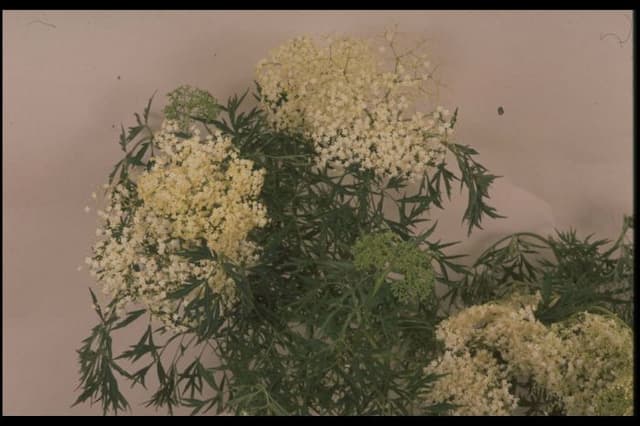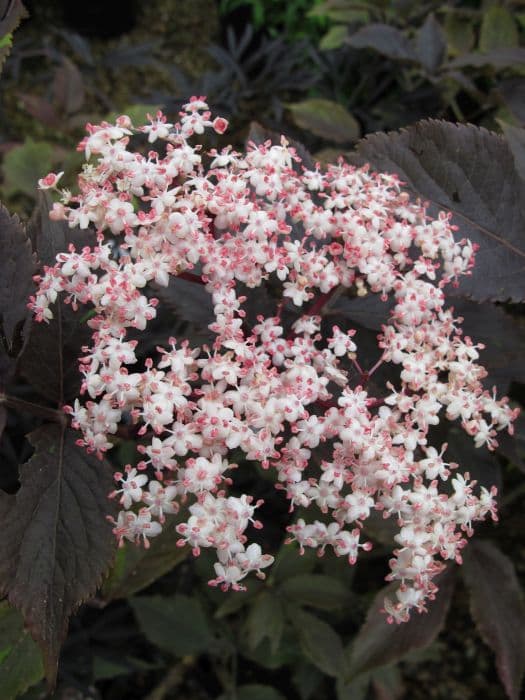Bodnant Viburnum Viburnum × bodnantense 'Charles Lamont'

ABOUT
Viburnum × bodnantense 'Charles Lamont', commonly known as Bodnant viburnum, is a deciduous shrub known for its striking appearance throughout different seasons. During the colder months, it showcases a stunning display of fragrant flowers that range in color from pink to blush white. These blooms stand out against the bare stems, lending winter gardens a burst of color and scent. As winter turns to spring, the Bodnant viburnum's flowers give way to fresh green foliage. Leaves are oval-shaped and have a somewhat wrinkled texture with serrated margins, providing a lush backdrop for the late winter blooms if they overlap or for other plants come spring and summer. In the autumn, this viburnum transitions again as leaves take on beautiful shades of red and purple, signaling the change of season. These colorful leaves last until they eventually drop, and the cycle of winter blooms begins anew. Throughout the year, the shrub maintains a strong, upright form. Its branching structure adds an architectural element to the landscape even when it is not in flower or leaf. The stems are robust and bear the weight of the flowers and foliage effortlessly, blending strength with the ornamental beauty the Bodnant viburnum is celebrated for. Aside from its seasonal changes, the plant produces small, dark berries that can attract wildlife. These berries are not a prominent feature when compared to the showy flowers and colorful foliage but still add to the overall interest of the shrub. In garden landscapes, Viburnum × bodnantense 'Charles Lamont' is appreciated for its multi-season appeal and ease of care, bringing beauty and attracting pollinators to gardens without needing much in return.
About this plant
 Names
NamesFamily
Adoxaceae
Synonyms
Bodnant Viburnum, Arrowwood 'Charles Lamont', Bodnantense Viburnum 'Charles Lamont'
Common names
Viburnum × bodnantense 'Charles Lamont'.
 Toxicity
ToxicityTo humans
Bodnant viburnum is not considered to be highly toxic to humans. However, like many plants, it may cause mild stomach upset if ingested in large quantities. In general, eating parts of ornamental plants is not advisable as they are not intended for human consumption, and sensitive individuals may experience more significant reactions.
To pets
Bodnant viburnum is also not known to be highly toxic to pets. However, if a pet were to ingest a large amount of the plant, they might experience mild gastrointestinal upset, such as vomiting or diarrhea. It is always a good practice to discourage pets from eating ornamental plants as a precautionary measure.
 Characteristics
CharacteristicsLife cycle
Perennials
Foliage type
Deciduous
Color of leaves
Green
Flower color
Pink
Height
8 feet (2.44 meters)
Spread
6 feet (1.83 meters)
Plant type
Shrub
Hardiness zones
6
Native area
Hybrid
Benefits
 General Benefits
General Benefits- Seasonal Interest – The plant offers winter blossoms during a time when few other plants are flowering, adding color and vibrancy to the garden in the cooler months.
- Attractive Fragrance – It produces fragrantly scented flowers that can perfume the air around the planting area, providing a sensory benefit.
- Wildlife Attraction – It serves as a food source for various pollinators, including bees, which are vital for a healthy ecosystem.
- Landscape Diversity – The shrub contributes to the biodiversity of a garden by adding a different form and texture compared to other plants that typically dominate winter landscapes.
- Easy to Grow – It is known for being hardy and adaptable to a range of soils and climates, making it a good choice for gardeners of varying experience levels.
- Decorative Berries – After flowering, it can produce berries that are attractive to birds, offering additional wildlife support and visual interest.
- Screening and Privacy – Because of its size and density when fully grown, it can be used as a hedge or screen to provide privacy or hide unsightly views.
- Four Season Interest – Aside from winter flowers, it has attractive leaves that can change colors in the fall, providing year-round interest in the garden.
- Versatility in Landscaping – It can be planted as a specimen, in groups, or as part of a mixed border, making it a versatile choice for many garden designs.
 Medical Properties
Medical PropertiesThis plant is not used for medical purposes.
 Air-purifying Qualities
Air-purifying QualitiesThis plant is not specifically known for air purifying qualities.
 Other Uses
Other Uses- Viburnum × bodnantense 'Charles Lamont' can serve as a natural privacy screen when planted in rows along property boundaries due to its dense foliage.
- Branches of the Bodnant Viburnum can be used in floral arrangements, especially since they bloom in the winter, providing color when few other plants do.
- The plant's berries can be used to create natural dyes for textiles, yielding various shades depending on the mordant used.
- Gardeners may use the plant to create a focal point in a winter garden as it flowers at a time when most other plants are dormant.
- Bodnant Viburnum can be used as a windbreak in coastal gardens due to its sturdy nature and tolerance of windy conditions.
- The dense growth habit of the plant makes it suitable as a backdrop for spring and summer flowering plants, providing contrast and structure.
- Its fragrant flowers can be utilized to make naturally scented potpourri or sachets for home fragrance without synthetic chemicals.
- The woody stems of mature Bodnant Viburnum can be used for small woodworking projects or as natural stakes in the garden.
- Incorporate cut stems with buds into indoor arrangements and they will often bloom when brought into the warmth of the home during winter.
- The plant's multi-season interest, including flowers, berries, and fall foliage, makes it good for themed gardens, such as sensory or wildlife gardens.
Interesting Facts
 Feng Shui
Feng ShuiThe plant Bodnant Viburnum is not used in Feng Shui practice.
 Zodiac Sign Compitability
Zodiac Sign CompitabilityThe Bodnant Viburnum is not used in astrology practice.
 Plant Symbolism
Plant Symbolism- Renewal: Viburnum × bodnantense 'Charles Lamont', commonly known as Bodnant Viburnum, often blooms during late winter to early spring, symbolizing the end of the cold season and the promise of renewal and new beginnings.
- Persistence: Its ability to flower even in the coldest months demonstrates resilience and the persistence of life in spite of challenging conditions.
- Beauty and Elegance: With its pink to white fragrant flowers, this plant represents the beauty and elegance that can be found in nature, reminding us to appreciate the aesthetics around us.
 Water
WaterBodnant Viburnum, commonly known as Viburnum × bodnantense 'Charles Lamont', thrives when the soil is kept moist but not waterlogged. During the active growing season in spring and summer, water the plant deeply once a week, supplying about 1.5 gallons per watering for a mature shrub to ensure moisture reaches the root zone. In hot or windy weather, check soil moisture frequently as additional water may be needed. During the dormant season in fall and winter, reduce watering to every other week or less, depending on rainfall and soil drainage. Always adjust your watering schedule based on weather conditions and the plant's appearance.
 Light
LightThe Bodnant Viburnum prefers full sun to partial shade, making it versatile for garden placement. It does best with at least four to six hours of direct sunlight but can tolerate some shade, especially in hotter climates. A spot that receives morning sun and afternoon shade would be ideal to protect the plant from intense heat while ensuring sufficient light for healthy growth.
 Temperature
TemperatureBodnant Viburnum is hardy and can withstand a range of temperatures, but it thrives best when the average temperature is between 60°F and 75°F. The plant can survive minimum winter temperatures down to 0°F, ensuring that it can endure cold climates. During summer, it can tolerate heat up to 90°F, but it's important to provide adequate water during these times to prevent stress.
 Pruning
PruningPrune Bodnant Viburnum immediately after the flowers fade in late spring to maintain shape and promote vigorous growth. Remove any dead or damaged wood, and thin out dense branches to improve air circulation. Pruning is also an opportunity to control the size of the plant if desired. Annual pruning is sufficient for this vigorous shrub, and an occasional rejuvenation prune every few years can help maintain its health and appearance.
 Cleaning
CleaningAs needed
 Soil
SoilBodnant Viburnum thrives in moderately fertile, well-drained soil with a pH range of 5.6 to 6.6. A mix of loam, peat, and coarse sand in equal parts can provide the drainage and nutrients necessary for optimal growth. Mulching with organic compost can also benefit soil structure and fertility.
 Repotting
RepottingBodnant Viburnum is typically planted in the ground and not commonly repotted. However, if you must repot or transplant, do so in the early spring every 3 to 5 years, or when it outgrows its current space.
 Humidity & Misting
Humidity & MistingBodnant Viburnum prefers average humidity levels but is adaptable to various conditions. It does not have specific humidity requirements, making it suitable for most outdoor garden environments.
 Suitable locations
Suitable locationsIndoor
Not suitable for indoor growth; needs outdoor space.
Outdoor
Plant in well-drained soil; full sun to partial shade.
Hardiness zone
5-9 USDA
 Life cycle
Life cycleThe life of Bodnant Viburnum 'Charles Lamont' begins with seed germination, typically occurring in a cold, moist environment that simulates winter, in a process called stratification. After germination, seedlings emerge and develop into juvenile plants, characterized by rapid vegetative growth and the establishment of a strong root system. As the plant matures into its adult phase, it develops woody stems and begins to produce flower buds, typically in late autumn, which then bloom in late winter to early spring, showcasing fragrant pink flowers. Following pollination, often by insects, the flowers give way to small, oval red fruit that matures to black, containing seeds for the next generation. Throughout the growing season, the plant also experiences vegetative growth, expanding its foliage with new leaves, and increasing in height and spread. Annual cycles of growth, flowering, and fruiting continue for many years, with proper care ensuring the longevity and health of the plant until it eventually senesces and dies.
 Propogation
PropogationPropogation time
Late Winter to Early Spring
Viburnum × bodnantense 'Charles Lamont', commonly known as the Bodnant Viburnum, is most commonly propagated through semi-ripe cuttings. The ideal time for taking these cuttings is during the late summer, typically from July to September. Take cuttings of about 4 to 6 inches (10 to 15 centimeters) long from the current season's growth, ensuring each cutting has a few leaves. Strip the leaves from the lower half of the cutting and dip the cut end into a rooting hormone to encourage root development. Then, insert the cutting into a well-draining potting mix or a mixture of peat and perlite. Maintain a humid environment by either placing a plastic bag over the pot or keeping the cuttings in a mist unit until roots develop, which typically takes several weeks. Once rooted, the cuttings can be potted individually and grown on before planting out.









